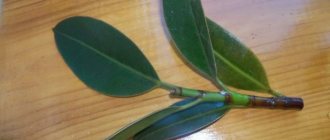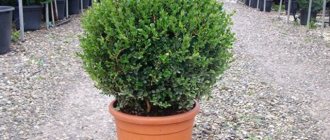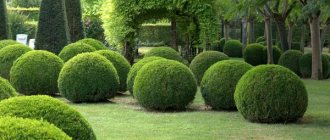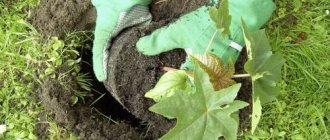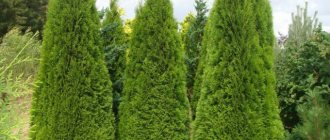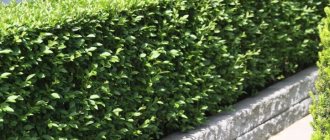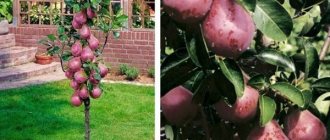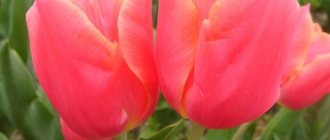Boxwood is a genus of plants that is an evergreen tree or shrub that is grown as an ornamental crop. Boxwood is valued for its excellent shear tolerance and the ability to shape the crown into any shape. Evergreen boxwood (Buxus sempervirens L.) can be found on almost every continent on the globe. It can be called differently: shamshit, buxus, bukshan, iron tree.
Planting and caring for boxwood
- Planting: from mid-September to early October, but if necessary, in spring and even summer.
- Flowering: the plant is grown as an ornamental foliage plant.
- Lighting: shade or partial shade.
- Soil: any, but preferably calcareous, loose and well fertilized.
- Mulching: in early May with a layer of organic matter 5-8 cm thick.
- Watering: after planting, the first watering is a week later. In the future - regular watering at a consumption of 1 bucket of water per meter-high bush. During drought, watering is carried out according to the same scheme, but the consumption is doubled.
- Fertilizing: after planting, fertilizers are applied no earlier than a month later. Subsequently, during the period of active growth, organic matter and complete mineral fertilizers are added to the soil, and in the fall - only a potassium-phosphorus complex.
- Pruning: in April or early May.
- Reproduction: usually by cuttings, but also by seed.
- Pests: boxwood gall midges, psyllids, moths, scale insects, false scale insects, mealybugs, felt mites, spider mites and gall mites.
- Diseases: root rot, rust, shoot necrosis, cancer.
Read more about growing boxwood below.
Planting at home
Professional gardeners say that only autumn is suitable for planting. As a rule, boxwood needs 1.5 months to take root , so all plants need to be planted before frosts begin.
How to plant it correctly? The most important thing to do is to remove the lump of earth with the flower. But before this, the soil needs to be moistened. A hole is prepared for the bush, taking into account the size of the coma - it should be 3 times wider than the roots.
Expanded clay is poured onto the bottom, and then the root is carefully inserted and the plant is compacted. Chernozem, turf and sand are used as a substrate.
By shoots
Cultivation can be carried out using seedlings . You can buy them in a specialized store.
Seeds
As a rule, to propagate boxwood, a vegetative method is used, but at home, seeds are often used. To grow buscus you will need fresh seeds. They are filled with water diluted with a growth stimulating agent.
It should remain in this state for a month, after which white sprouts will appear. Planting is carried out in sand with peat, burying the sprouts in the substrate.
Containers with planted materials are covered with film and kept in a shaded place. After 20 minutes, the first shoots appear, after which the film is removed.
Botanical description
Boxwood leaves are opposite, entire, leathery, elliptical or almost round. The flowers are fragrant, small, unisexual, collected in axillary inflorescences. The fruit is a three-lobed capsule that cracks when ripe and scatters shiny black seeds. Boxwood is a honey plant, but boxwood honey cannot be consumed, since all parts of the plant are poisonous. Landscape designers value boxwood for its beautiful crown, shiny leaves and ability to tolerate pruning well. Gardeners, among other things, value decorative boxwood for its unpretentiousness and shade tolerance.
The most popular varieties of boxwood
In central Russia, it is best to grow frost-resistant types of buxus that can withstand short-term drops in temperature to -32°C. These include, first of all, small-leaved Asian varieties. However, it is not they that are most widespread, but the variety Buxus sempervirens - evergreen buxus (European or ordinary), which adapts well to any unfavorable conditions. It also has other advantages over its “relatives”.
European evergreen
Buxus sempervirens is ideal in hedges and decorative borders, with an average height of 2 m. It is also suitable for topiaries with simplified large shapes, most often spherical. This is a bright accent of any landscape design, low maintenance and resilient. Feels good in an urban environment, without suffering from excessive gas pollution and other environmental problems of the metropolis. On poor soils it produces shorter shoots, but they are dense and quite suitable for decorative cutting.
It can be grown in tubs, where, thanks to the natural massiveness of the crown, it looks very impressive. But Buxus sempervirens should not be used as a houseplant - it is disproportionate to modern interiors, needs frequent watering and spraying, and is acutely sensitive to a lack of light.
The most widespread varieties are:
- Suffruticosa;
- marginata;
- Elegans;
- Blauer Heinz;
- King Midas;
- Angustifolia.
Among them, the Elegans variety stands out with a natural spherical shape, which is most organic in today's fashionable landscape gardens.
Boxwood Elegans
Asian small-leaved
This species, also known as Buxus microphylla, was introduced from Japan and China. It is distinguished by coin-shaped leaves, 1.5 - 2.5 cm long, which form a very graceful dense crown. Most varieties are miniature, reaching a height of no more than 1.5 meters. Asian buxus is used for parterre flower beds and topiaries, trunks and bonsai. It feels comfortable in tubs and pots and adapts better to being kept indoors than its European relative.
Insensitive to frost, but can die from overwatering and rotting. The decorative properties of Buxus microphylla are best revealed in Japanese gardens. There, boxwood bushes are arranged compactly in several pieces and give them a spherical shape of different sizes. In combination with stone decor and small garden forms, the result is an artistic and creative landscape.
Buxus microphylla Golden Dream and Sunburst
Balearic
Buxus balearica is the fastest growing and heat-loving species of the Boxwood family, native to the Mediterranean. A lush shrub with large lanceolate leaves up to 5 cm is afraid of the cold, and therefore is grown only in the southern regions of Russia. In its homeland - Spain, it is listed in the Red Book as endangered. Despite its beauty, the plant is rarely cultivated because it needs constant attention.
Fast growing Buxus balearica
Planting boxwood
When to plant
If you adhere to the folk wisdom that says that plants that bloom in spring are best planted in autumn, and vice versa, it is better to plant boxwood in the autumn, from mid-September to early October, giving it a month to take root before the onset of cold weather. Although some gardeners successfully plant boxwood in early spring and even summer. It is best to plant the plant in a semi-shaded or shady place, in clay, moist and permeable soil containing lime. In bright sun, boxwood leaves quickly become damaged.
How to plant
A day before planting in open ground, boxwood seedlings with a closed root system need to be watered abundantly to make it easier to remove the root system with an earthen lump from the container. It will be even better if you can remove the seedling and immerse its roots in water for a day. The hole for boxwood should be approximately three times deeper and wider than the earthen ball with the roots of the seedling. A drainage layer of perlite 2-3 cm thick is placed at the bottom of the hole, and the soil removed from the hole is also mixed with perlite in equal parts. The roots of the seedling are straightened, placed in a hole and the roots are gradually covered with a mixture of soil and perlite, trying to avoid the formation of air cavities.
- How to prolong the flowering of gladioli
After filling the hole, lightly compact the soil and water the seedling with settled rainwater (for a seedling height of 15-20 cm, you will need 3 liters of water). When the soil in the hole sags after watering, add more soil mixture, but do not compact it. The trunk of the boxwood should be positioned strictly vertically. 20-30 cm from the stem, pour a low earthen bank around the circumference so that during further watering the water does not spread, but goes deeper, and cover the near-trunk circle inside the circle with a layer of perlite 1-2 cm thick.
Long-liver with character: description and advantages
Boxwood, or buxus (from Latin Buxus) is a slow-growing evergreen shrub or tree with a height of 0.7 to 15 m. It is widespread in East Africa, the Mediterranean, Asia Minor and Central America.
If boxwood is chosen for landscaping the local area, planting and caring for it in open ground will require the gardener to be attentive. But at the same time, a highly decorative bush will grow in the garden area, retaining its attractiveness for a long time. The lifespan of a buxus in nature reaches 500-600 years. For example, Nana fir cannot boast of such indicators. On the site, life expectancy is limited to several decades.
Boxwood plantings
Despite its apparent mediocrity, the shrub attracts gardeners with its glossy green leaves. The upper part of the leaf blades is dark, and the lower part is light, yellow-green. The leaves are elliptical in shape and remain on the branches all year round. In autumn, their color changes from green to dark brown.
Another reason to grow buxus is its pleasant aroma. It produces small yellowish-green flowers that bloom in April or May. Over time, fruit boxes measuring 1-1.5 cm in size form in their place.
Slow growth is a characteristic of the plant. The annual growth is 5-6 cm.
In wild conditions, the plant reaches 15 m; when grown on a plot, a maximum height of up to 6 m can be achieved. Boxwood, with proper care, is not capricious. Its main advantages:
- cold-resistant varieties can withstand temperatures down to -20 °C;
- tolerates heat without loss;
- withstands short-term waterlogging and drought;
- grows within the city, where the air is smoky and contains an increased amount of gases;
- responds painlessly to transplantation at any age;
Flowering begins at the end of April
- lends itself to any haircut, retains its shape well, so gardeners love to make geometric shapes and animals from it.
How to choose the best boxwood seedlings?
Plants are sold with an open or closed root system. If it is a closed type, then such a specimen can be planted in the summer. Specimens with an open root system require preparation before planting. The roots must be trimmed and placed in a bucket of warm water. Planting of such a sample is carried out only in the spring.
Signs of a quality seedling:
- the foliage is green and lush, without damage;
- yellow spots are a sign of a disease, so they should not exist;
- soil in a container without mold;
- the earthen lump is braided with roots.
When growing this representative, it is important to remember that it is poisonous. The composition contains the alkaloid buxin, which in toxic quantities causes vomiting, convulsions and respiratory arrest. In most cases, it is dangerous for domestic animals when branches after pruning are used as bedding.
Caring for boxwood in the garden
Growing conditions
Growing boxwood is not at all a troublesome task, and if you do not know how to care for boxwood, follow the general rules of gardening and simple logic. After planting, if there is no rain, water the boxwood every other week. Water consumption for further watering is approximately one bucket per meter-high plant. Water must be poured inside the circle that you marked with an earthen roller. You need to water boxwood in the morning or evening, and during droughts or dry hot winds, you need to water boxwood not more often, but more abundantly.
After watering, be sure to loosen the soil, while simultaneously removing weeds from the area. At the beginning of May, when the earth has already warmed up sufficiently, the trunk circle of the boxwood is mulched with a layer of peat 5-8 cm thick, but in such a way that the mulch in no case comes into contact with the shoots and trunk of the boxwood.
Caring for boxwood involves regular feeding of the plant. The first time boxwood is fertilized only a month after planting, if you planted it in the spring, since only a rooted plant can be fertilized. Subsequently, during the period of active growth, complex mineral fertilizers or organic matter are added to the soil, and in the fall, when digging into the soil, only those fertilizers that contain potassium and phosphorus are applied, since the plant does not need nitrogen in autumn and winter.
Transfer
It is better to replant boxwood in the spring so that the plant has time to take root safely and prepare for winter. Adult plants need to be replanted together with a lump of earth. Boxwood transplantation is carried out according to the same principle as the initial planting, and if you do everything correctly, the plant will undergo the procedure painlessly.
A haircut
Boxwood pruning is carried out in April or early May. You can form a boxwood bush in the form of a geometric figure - most often these are cubes, cones or balls. You can grow boxwood as a standard tree, leaving only the central, strongest shoot on it, and cutting out all the others at the root. Young shoots growing in the upper part of the central shoot of the trunk are usually given the shape of a ball. Once the plant is formed, you will only have to slightly adjust the shape, since boxwood grows very slowly.
When making adjustments, usually only young growths are pruned; pruning of old wood can only come about if the bush has completely lost the required outline. Boxwood tolerates cutting very easily, and the more often you cut it, the thicker it becomes. Professionals recommend adjusting the boxwood crown monthly. However, keep in mind: the more often you prune your boxwood, the more often you will need to water and feed it so that it can replenish the lost nutrients provided by the pruned leaves.
Pests and diseases
The main enemy of the plant is the boxwood gall midge, which lays its eggs in early summer in young leaves at the ends of the shoots. The hatched larvae eat into the leaf tissue and overwinter there, and in May adult insects emerge from their pupae. If the occupation of boxwood by gall midges is total, its leaves dry out and fall off. The fight against boxwood gall midge is carried out with the following drugs: Aktara, Karbofos, Fufanon, Tagore. If after one treatment you do not notice any improvement, repeat spraying after ten days. The same insecticides will help you in the event of the appearance of felt moth on the boxwood, the vital activity of which is manifested by swelling on the leaves and wilting of the shoots. Spider mites, which appear on the plant during severe dry weather, are also destroyed by the listed drugs.
Among the diseases, boxwood suffers from necrosis of shoots, accompanied by the death of the ends of branches and spots on the leaves. This disease is treated with fungicide treatment, and possibly repeated. The worst thing is if boxwood is affected by cancer. If this happens, trim the affected areas of the plant, taking in healthy wood, and treat the wounds with Fundazol.
Boxwood in Moscow and Moscow region
Planting and caring for evergreen boxwood in Moscow and the Moscow region is not much different from the plant’s agricultural practices in other areas with a temperate climate. However, in places where winter frosts are very severe, measures to prepare boxwood for winter cannot be neglected. Read about how to ensure a safe winter for the plant in the corresponding section.
Diseases and pests
Buxus is susceptible to fungal diseases and is loved by a large number of insect pests.
The most dangerous of them for boxwood are:
- Boxwood gall midge. Outwardly it looks like a small mosquito. This parasite creates yellow growths on the leaves and lays larvae. Trimming the boxwood and treating it with special products helps in the fight against it. For example, “Karbofos”, “Lightning”, “Fufanon”.
- Leaf flea. A small jumping insect that attacks boxwood leaves. The flea secretes a white waxy coating under which its larvae live. They feed on a tree leaf. You can notice this when the leaves begin to swell, curl or bend. It is not difficult to get rid of this scourge. You just need to remove the affected leaves, spray the plant with an insecticide and then with mineral oil.
- Spider mite. Appears on the plant at high air temperatures and prolonged drought. Very small insects are located on the back of the leaves. At the same time, the shoots and branches are tightly entangled in cobwebs. The leaves lose density, turn yellow, dry out and die. To combat it, it is recommended to spray the plant with Fufanon or Actellik. For minor lesions, you can simply treat the twigs and leaves with a soap solution.
- Felt. Another name for the hairy louse or boxwood bug. They appear mainly at the beginning and end of summer. Eggs are laid on the back of the leaf. These are sucking insects, which must be combated, otherwise the plant may die within 2 years. You can destroy the mealybug by treating the bush with mineral oils, first removing the affected areas.
- Boxwood moth. This caterpillar was brought with new seedlings to our country from Italy. The fight against it has been going on for several years in Sochi. It affects a huge number of trees and shrubs. Entire boxwood groves on the resort territory were destroyed. These caterpillars are lime-green in color, web the entire plant, and eat its leaves. Boxwood dries quickly and the leaves turn yellow. The plant dies. To destroy the pest, you need to spray not only the tree itself, but also the ground around it, with a radius of about half a meter. In the early stages, the insecticide “Dimilin” copes well with this. But if time is lost, it is better to use such means as “Bi-58”, “Vega”, “Fury”, etc.
Boxwood is predisposed to diseases such as septoria, rust, stem rot, cytosporosis, etc. Most of the diseases listed are related to fungal infections. To help the plant, it is necessary to remove and destroy all affected areas, and treat the tree itself with fungicides or products containing copper.
Boxwood propagation
Reproduction methods
Boxwood is most often propagated vegetatively, but sometimes the seed propagation method is also used. The problem is that boxwood seeds lose their viability very quickly, but if you want to try growing a bush from a seed, use our recommendations.
Growing from seeds
Fresh, just ripened seeds are soaked for a day in warm water with a growth stimulator - Epin or Zircon. They are then spread between two damp (not wet) towels or napkins and wait until the white sprouts appear - usually this happens after a month, during which time you must keep the cloth in which the seeds are kept moist. If sprouts do not appear within 2-3 weeks, place the napkins with seeds in the vegetable drawer of the refrigerator for several days, and then move them back to a warm room.
After white sprouts appear, the seeds are sown in a mixture of peat and sand in equal parts, directing the sprouts into the soil, and cover the container with glass or film. The container is kept in a warm place in partial shade and seedlings are awaited, which should appear within two to three weeks. As soon as the green sprouts hatch, the film or glass is removed and the container is moved to partial shade. Caring for seedlings involves watering and fertilizing young plants with fertilizers of a weak consistency. Strengthened and grown seedlings are planted in the ground after return frosts have passed.
- How to care for field bindweed in the garden
Propagation by cuttings
Spring cuttings of boxwood are the most common method of propagating this shrub. For cuttings, young, strong, but not completely lignified shoots 10-15 cm long are prepared, which are cut obliquely, and, after removing the leaves from the lower third of the cutting, they are soaked for a day in a root-forming solution. Then the cuttings are washed and planted in open ground with approximately the following composition: old, long-rotted compost or humus, leaf soil and sand in equal parts.
The composition may be different, the main thing is that the soil is light and nutritious.
The cuttings are buried in the substrate up to the leaves and each is covered with a five-liter plastic bottle with a cut out bottom. To water the cutting, you will need to unscrew the cap of the bottle and spray water inside from a spray bottle. In the same way, you can ventilate the cuttings daily. The roots begin to form in a month, and after two months the boxwood will already have a root system formed, and the bottle can be removed. Do not forget to cover the cuttings with spruce branches during the first winter, otherwise they will die.
Boxwood can be propagated by cuttings in the fall, but they need to be planted in pots, since they will not have time to take root and become stronger before winter, so they will probably die even under cover. The cuttings need to be brought into a room with a temperature of 10 ºC, where they will wait out the winter cold, and in the spring they will be planted in a permanent place.
Reproduction by layering
This is another reliable and proven method of vegetative propagation. In spring, boxwood shoots are bent to the ground and buried. All summer they are watered and fed together with the mother bush, and when they take root and begin to grow, they are separated and planted in a permanent place.
How to plant boxwood
You can grow this shrub from seeds, but the seed method is very labor-intensive and time-consuming. Therefore, it is best to propagate boxwood from cuttings on your site. Cuttings can be carried out throughout the season, but the best time is spring. If your neighbors are trimming their boxwood or you see shrubs being trimmed in the park, pick up some twigs and you'll have free planting material. But it is easier and better to propagate boxwood by dividing the mother bush, since in this case the survival rate of the plant in a new place is much higher. The fact is that the root system of young plants is quite weak, and the roots really love moisture. Therefore, if you do not water the bush on time, it will simply dry out.
Site selection
Boxwood has no special requirements for soil composition. The plant is not demanding, and it does not need black soil or fertile, rich soil. But in soil rich in nutrients, the shrub will grow very well. In poor soil, plant growth slows down. When choosing a site, preference should be given to a place where water does not stagnate. The plant loves watering, but does not like stagnant moisture. If groundwater is close to your site or water remains standing for a long time after snow melts or rains, then it is better to grow boxwood in pots.
Boxwood in winter
Autumn work
The most difficult period in cultivating boxwood is winter - the evergreen shrub is very sensitive to cold temperatures. In addition, the dormant root system does not provide the shoots and leaves of boxwood, which awaken to life at the first ray of sun, with moisture and nutrition, which is why they dry out. This is why it is important to plant boxwood in the shade. And this is why it is so important to take all necessary measures to prepare boxwood for winter.
Immediately before the onset of frost, in early November, it is necessary to carry out abundant pre-winter watering of boxwood, which will saturate the plants with moisture for the long winter months. After this, you need to mulch the tree trunk circles with rotted pine needles or peat. Dry leaves are not suitable for this, because in a wet winter they can support and provoke the development of fungal diseases in the boxwood.
Boxwood shelter for the winter
When the air temperature drops to -10 ºC, they begin to organize the boxwood shelter. Before covering the boxwood for the winter, standard plants need to be tied to a support so that heavy snowfall does not break the boxwood stem. After this, you should completely wrap the trunk with non-woven material or tie it with spruce branches. In adult trunks, you can whiten the trunk, then only the crown of the plant will need to be tied with fabric. A border or hedge made of boxwood also needs shelter - they are completely covered with two or three layers of non-woven material or burlap, which are secured by sprinkling the edges with earth. But first the boxwood bushes need to be tied up - large masses of wet snow can break its branches.
Rooted cuttings and young boxwoods are tied with spruce branches, and the tree trunk circles are mulched with peat or pine needles. Remove the cover as soon as spring comes, otherwise the boxwood may dry out in the warmth. They do this on a cloudy day, and not all coniferous paws and layers of fabric are removed - leave one layer of burlap, lutrasil or spunbond and a little spruce branches for shading from the too bright spring sun. You need to gradually accustom boxwood to spring.
Shrub care: watering, fertilizing, pruning
The rules for caring for boxwood include watering, fertilizing, pruning and preparing for winter. It is enough to water the bush once a week during the entire growing season in the absence of rain for a long time. The first application of fertilizers is made a month after planting, then the bush is fed monthly. In the spring, buxus will need nitrogen fertilizers, in the summer and autumn - potassium and phosphorus.
Fertilizers for ornamental shrubs:
- specialized drug "Buxus-Azet";
- mineral complex PETER PEAT;
- For organic fertilizers, mullein solution (1:10) and bird droppings (1:20) are suitable.
The main reason for choosing a boxwood bush is its predisposition to form topiary figures. From the evergreen buccus you can grow a ball, cube, pyramid and more complex shapes. To maintain the shape, only new growth is pruned. Trimming stimulates the branching of the bush. The frequency of the procedure is once every 4 weeks. In the Moscow region, pruning can begin in April.
Haircut of young growth
Boxwood shelter for the winter
One of the difficult stages in care is the transition of boxwood into a dormant state and its wintering. The boxwood tree is prepared in advance for the onset of cold weather. In the fall, before frost, it is watered abundantly. The tree trunk circle is mulched to prevent the root system from freezing. It is better to cover the soil with peat rather than foliage, since during the winter it can rot and block the access of air to the roots.
Covering methods:
- Small specimens can be covered with boxes with ventilation holes. Large bushes and hedges are insulated with non-woven material or spruce branches.
- Border plantings are covered with non-woven insulation, burlap or special nets to prevent branches from breaking off under the snow.
- Standard boxwoods are tied to supports and wrapped in spruce branches.
Boxwood in winter in the Moscow region needs to be protected from sunlight. Most often, the plant suffers from bright rays, and not from cold. The bush is at rest, and if there is an excess of light in the leaves, the process of photosynthesis can begin. When the soil is frozen, the plant goes hungry, which can cause it to turn brown, dry out, or even die. In the spring, with the arrival of warmth, the shelter is removed as soon as possible so that fungal diseases do not begin to develop.
Boxwood caterpillar
Types and varieties
There are not many types of boxwood grown in cultivation, but it has very attractive garden forms that we would like to introduce you to. So:
Evergreen boxwood (Buxus sempervirens)
Distributed in nature in the Mediterranean and the Caucasus, where it prefers to grow in the undergrowth of deciduous and mixed forests, even in dense shade. This is a tree up to 15 m high, and much less commonly a shrub. The shoots of this species are straight, tetrahedral, densely leafy, and green. The leaves are opposite, almost without petioles, bare, shiny, dark green on the upper side of the plate and matte light green, even yellowish, on the bottom. The shape of the leaves is elongated-elliptical, length from 1.5 to 3 cm. Small unisexual greenish flowers are collected in compact capitate inflorescences. The fruit is a small spherical capsule with valves that open when the seeds ripen. All parts of the evergreen boxwood are poisonous! The best varieties:
- Suffruticosa is an evergreen shrub that grows slowly and strictly vertically up to 1 m in height. The leaves are ovate or obovate, opposite, up to 2 cm long. The flowers are small. The plant is ideal for hedges and borders;
- Blauer Heinz is a squat, slow-growing shrub with stiffer shoots than Suffruticosa and leathery bluish-green leaves. This is a relatively new variety, which is used to create carpet patterns no higher than 20 cm. More compact and frost-resistant than the previous variety;
- Elegance is a dense shrub with a spherical crown up to 1 m high with straight, densely leafy shoots and oblong variegated leaves with a white border. Drought resistant.
Small-leaved boxwood (Buxus microphylla)
Unlike evergreen boxwood, this species is much less sensitive to winter frosts. This is a Korean or Japanese descendant of boxwoods, which can withstand thirty-degree frosts in winter without shelter, but nevertheless needs shelter from the bright spring sun. The most popular varieties in cultivation:
- Winter Gem is a very frost-resistant boxwood variety with a dense crown, which is great for creating small topiary forms. Tolerates pruning well. A fast-growing variety rare for boxwoods, reaching a height of 1.5 m;
- Faulkner is a compact, slow-growing shrub up to 1.5 m high; most often its bushes are pruned in the shape of a ball, which is favored by the natural growth of the crown.
Colchian or Caucasian boxwood (Buxus colchica)
A slow-growing relict of the Tertiary period, which is the smallest-leaved and winter-hardy boxwood of the European species. This species lives up to 600 years, reaching a height of 15-20 m, the diameter of the trunk at the base is 30 cm.
Balearic boxwood (Buxus balearica)
It is the most western type of boxwood. It is native to the Balearic Islands, southern Spain, Portugal and the Atlas Mountains in northern Morocco. This is the largest-leaved species of the Euro-Asian range: the Balearic boxwood leaf reaches a length of 4 and a width of 3 cm. It grows quickly, has extremely high decorative qualities, but, unfortunately, is not winter-hardy at all.
- Lunnik: planting and care, types and varieties
There are several other types of boxwood that can be cultivated in our climate, but so far they are very rare in our gardens.
Description of the plant
Boxwood evergreen (Buxus sempervirens) is a genus of evergreen shrubs and small trees from the Boxwood family. Under favorable conditions, the plant can live up to 600 years. Buxus grows slowly.
The medium-sized succulent leaves have an ellipse shape and a characteristic odor. Most species have green foliage, but there are also variegated varieties. Spikelets of greenish-yellow flowers appear in the leaf axils in March or April. They are inconspicuous and fragrant. In place of the flowers, boxes with black seeds are formed. Over time, these fruits crack and their contents scatter around.
Indoor plant
Following the fashion for changing the functions of purely garden plants, boxwood is increasingly being grown at home. However, unpretentious and persistent on the site, once indoors, it begins to “show character.” The Asian small-leaved varieties Faulkner and Winter Gem are best suited for indoor keeping. Selected “home” boxwoods are also available for sale, but these are rare specimens with a corresponding price.
Variety Winter Gem
When growing indoors, you must provide:
- Sufficient but diffuse natural lighting. South, east and west windows with shading are suitable. It is not possible to replace sunlight with artificial light.
- The temperature should not exceed 23°C, and in hot weather, abundant watering, spraying, air humidification and regular ventilation. In winter, the room should not be colder than 12°C.
- Fresh air in the warm season. To do this, indoor buxuses are taken out onto a shaded balcony or veranda.
- Fertilize once a month, for young plants it can be 2 times more often. An excess of “nutrition” will cause rapid growth of the bush and its maintenance in the room will become problematic. The best option is fertilizer for rhododendrons.
Indoor specimens are pruned according to the garden principle. With patience and attention, from the Japanese variety Buxus microphylla var. Japonica can be formed into a bonsai.
